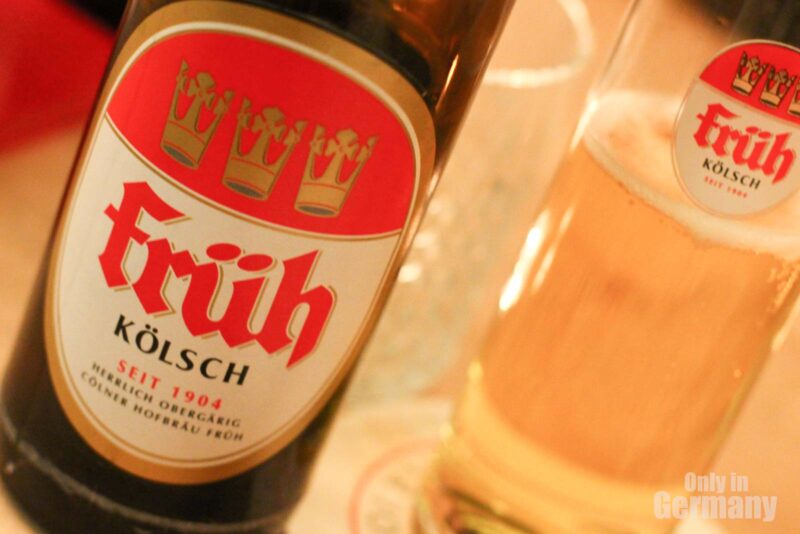30 Best German Beers To Try on Your Next Trip to Germany (2023)
Beer is one of the most popular drinks in Germany. The manufacturers offer many different types of beer. And so you can find many different ones among the German beers. Take a look at the most popular beer styles in Germany.
Beer is a carbonated and alcoholic beverage. In Germany it is even a national drink and German beer is also very popular abroad. Some varieties are only regionally distributed. So you have to come to Germany to drink them.
There are many, many types German beers.
Since beer is one of the most consumed beverages in Germany and other countries, manufacturers offer a wide variety of different types of beer. A total of over 5,000 different beers are produced in more than 1,350 German breweries.
Altbier
Altbier is a dark type of beer that is brewed top-fermented. the dark color that characterizes the Alt gets it from a higher proportion of kilned malt. Altbier is still brewed in the traditional way in some breweries today.
Altbier is a dark type of beer that belongs to the top-fermented types. Often it is also simply called old. Altbier is particularly popular on the Lower Rhine. So consider Dusseldorf, Moenchengladbach and Krefeld as veritable Altbier strongholds.
History of Altbier
The Altbier has its roots in Westphalia and Lower Saxony. In fact, until the late 19th century, Alt was the only type of beer made in this region. This type of beer is called Altbier because it is brewed in the traditional way. It is one of the top-fermented beers.
In traditional brewing methods, the yeast rises to the top of the beer during fermentation, while in modern methods it sinks to the bottom.
In earlier times it was common to sell top-fermented beers immediately after the main fermentation, which was due to their limited shelf life. In the present, however, the storage of top-fermented beers is similar to that of bottom-fermented beers.
Manufacturing of Alrbier
The production of Altbier involves higher temperatures than the production of bottom-fermented beers. In the past, this was a great advantage because the possibilities for technical cooling were not yet available.
The Altbier gets its dark color from a higher proportion of kilned malt. In this case, coloring forms through the roasting. Nowadays, some breweries in Düsseldorf, Krefeld and Neuss still brew Altbier in the traditional way.
Berliner Weisse
The Berliner Weisse is a top-fermented beer that has a typical dark yellow colour. In contrast to other types of beer, lactic acid fermentation takes place after the alcoholic fermentation in the Berliner Weisse.
A typical Berlin beer is the so-called Berliner Weisse, which is one of the top-fermented draft beers. The beer, which has an alcohol content of around 2.8 percent, is made from malted wheat and barley. A typical feature of the Berliner Weisse is its dark yellow.
In contrast to other types of beer, the Berliner Weisse is followed by lactic acid fermentation after the alcoholic fermentation. This is how the beer gets its typical sour taste.
A variant is the Berliner Weisse with shot. The beer is mixed with sweet fruit syrup. Woodruff syrup and raspberry syrup are particularly popular. Some beer drinkers also mix the beer with liqueur or sparkling wine.
History or the Berliner Weisse
The Berliner Weisse is believed to have originated in the 16th century. At that time, farmer Cord Broihan from Halberstadt tried to brew the valued Hamburg beer after a stay in Hamburg. The result was the Halberstadt Broihan, which spread throughout northern Germany.
In Berlin, however, the recipe was changed by some brewers, which led to the production of an even more digestible wheat beer. The first documented mention of the so-called Berlin wheat beer dates back to 1680.
Over the years it has become the most popular beer drink in Berlin. By the year 1800, around 700 wheat beer bars were established.
Due to their indication of origin, Berliner Weisse may only be brewed in Berlin. The largest brand of beer is Berliner Kindl. In addition, various small home breweries offer the popular drink.
Manufacturing of the Berliner Weisse
The most important ingredients of Berliner Weisse are barley and wheat. The fermentation method of the beer is based on a symbiosis top-fermenting yeast Brettanomyces yeast and Lactic acid bacteria such as Lactobacillus brevis.
After the first alcoholic fermentation, a lactic acid fermentation is then carried out, during which additional lactic acid is produced. The lactic acid extends the shelf life of the beer considerably. It can even be stored this way for a number of years.
Bockbier - strong beer
The strong beer has an original gravity of at least 16 percent and a minimum alcohol content of 6.5 percent. Bock beers are particularly popular strong beers. Some Irish beers are also strong beers.
The term “strong beer” serves as a collective term for beers that an original wort content of more than 16 percent. Besides that their alcohol content is at least 6.5 percent.
History of the Bockbier
There are different versions of how strong beer came about. There is a widespread story that the Salvator monks brewed it during lent to at least have enough liquid food. Other sources, on the other hand, assume that strong beer is actually a festival beer, which was produced by the Paulaner monks to celebrate the feast day of St. Francis of Paula.
Today, strong beer is part of the Bavarian festival and drinking culture. The traditional strong beer tapping on Munich’s Nockherberg, which ceremonially opens the strong beer season, is particularly well known.
Strong beers come in different varieties. Bockbier such as
- Weizenbock (Wheat Bock)
- Maibock
- Eisbock
- Festbock and
- Doppelbock (Double Bock)
Also count among the strong beers that Germans drink: Ale, Porter and Guinness beer.
Dark beer
Dark beer, also known as brown beer, refers to dark types of beer. In some places in Germany, dark beer is also called brown beer.
The shades of color of the numerous types of beer are very different. This is how they are divided into light and dark beers. A well-known type of dark beer is the dark, which is mainly preferred in Bavaria. This is a brown bottom-fermented beer with an alcohol content of 4.5 to 6.0 percent and an original gravity of 11 to 13 percent.
Since there is no precise demarcation to dark export beer, the same beer can sometimes be found in stores as “Export Dark” or “Dark”. The Bavarian dark beer is made using the Munich brewing method.
There are different types of dark beer. Among the most popular
- Schwarzbier (black beer)
- Bockbier (bock beer)
- Malzbier (root beer)
- Hefeweizen (wheat beer).
Export Beer
Export beer is a bottom-fermented full beer with an alcohol content that is usually over 5 percent. Export has a longer shelf life than some other types of beer and is available in both light and dark colors.
The export beers are brewed stronger so that when they arrive at their destination, they can be diluted with water to drinking strength.
Alcohol content of the export beers is usually over five percent and its original gravity is 12 to 14 percent. It is offered in both light and dark colors.
One of Export’s most important characteristics is its longer shelf life. In earlier times, the type of beer could therefore also be exported to other regions.
The beers intended for export were therefore brewed stronger. Once they reached their destination, they were diluted with water to drinking strength. In this way, the transport costs could also be limited. Due to its stronger taste and higher alcohol content, the export beer also gained popularity in the domestic regions.
There are different types of export beers. The best known are
- Munich Export
- Dortmund Export
- Viennese Export.
In some part is Germany, the term export is also used for other types of beer. These include, for example - strong beers or top-fermented ales.
Gose
Gose is a type of beer that comes from Goslar. This beer is an old type of beer, which was then produced by spontaneous fermentation. Today it is brewed using the top-fermenting method, so the beer goes through an additional bacterial lactic acid fermentation after the alcoholic fermentation.
The Gose beer originally comes from the town of Goslar am Harz. It is assumed that the name of the beer is derived from the small Harz river Gose. In the Middle Ages, brewers used river water to brew beer. From the Harz Mountains, the popular beer was able to spread until after Hall Dessau and spread Leipzig, where it was greatly appreciated.
History of Gose
According to legend, Emperor Otto III. (980-102) to the lovers of Gose beer. The oldest existing documentary mention of the beer type dates back to 1332. It was introduced in Leipzig in 1738, where it quickly gained popularity. At the beginning of the 20th century, Gose was so popular in Leipzig that the city was also called “Gosestadt”.
After the end of World War II, the Soviet occupying forces expropriated and dismantled the brewery in Döllnitz, which meant that Gose was no longer available in Leipzig. Between 1949 and 1966 at least some small breweries restored the special beer. However, when the last brewery gave up in 1966, there was no more Gose in Leipzig.
Gose celebrated its comeback in 1986, when a wheat beer brewery in Berlin brewed the beer again using its traditional recipe. Today, Gose is part of the offer of numerous Leipzig restaurants.
In Goslar, the production of Gose beer was already discontinued in the 19th century. Since 1993, however, the traditional beer has been available again there in various varieties.
Manufacturing of Gose
Gose beer is an old type of beer. Gose is quite similar to Berliner Weisse, but also to Belgian lambic beers, of which the Geuze is one of their special varieties. In earlier times, gose was produced by spontaneous fermentation.
In the present, the manufacturers fall back on the top-fermented brewing method. This means that not only alcoholic fermentation takes place, but also bacterial lactic acid fermentation. This is how the typical sour taste of the beer is created.
One of the peculiarities of Gose beer is the addition of coriander and table salt.
However, this does not correspond to the German Purity Law.
Helles
Yellow, bottom-fermented beer is called Helles. The alcohol content of Helles is between 4.5 and 6 percent. The color and appearance are similar to Pils. However, there are significant differences in taste.
Features of Helles
Helles is particularly popular in Bavaria. There it is brewed according to the Munich brewing method. Bavarian dark beers are made in the same way.
In Bavaria, after the Second World War, the Helle became the most important type of beer in the Free State. The color and appearance of the pale lager are similar to Pils. Depending on the brewery in which the beer is produced, however, differences in color are possible.
In terms of taste, the light indicates a medium fullness. Also malty aroma components are important. In contrast to Pils, it is significantly less bitter. Depending on the recipe, you can also a subtle hop aroma perceive.
Kölsch

Kölsch is a light, top-fermented full beer. Kölsch beers may only be produced in the greater Cologne area. There are around 40 different Kölsch brands in total. Kölsch is a very hoppy beer and the German Purity Law of 1516 is strictly observed during production.
If one speaks of Kölsch, this means a filtered, top-fermented and light full-bodied beer. It has an alcohol content of 4.8 percent and an original gravity of 11.3 percent.
Just like the Bavarian beer, the Kölsch also has a protected geographical indication in the European Union. This means that Kölsch beers can only be produced in the greater Cologne area.
There are around 40 different Kölsch brands in total.
History of Kölsch
It is said that beer has been brewed in Cologne since the 9th century, although this is disputed by historians. Beer brewing in Cologne, on the other hand, has been reliably documented since the 12th century.
In 1250, the Brauamt, the professional representation of the Cologne brewers, was founded in the cathedral city. In 1396 the Cologne brewery cooperation was established.
In 1429, the city council issued a purity law for beer for the first time. From 1516, the Bavarian Purity Law was also observed in Cologne.
By the 19th century, around one hundred house breweries had been established in the cathedral city. They brewed mainly top-fermented beers. Wiess, a cloudy and unfiltered beer, is considered the forerunner of today’s Kölsch.
Despite competition from other types of beer such as Export or Pils, which were offered by the large breweries, the top-fermented Kölsch could not be pushed out. However, over time it lost its turbidity.
The term “Kölsch” was used for the first time in 1918 by the Sünner brewery, which had been producing a light, top-fermented beer since 1906. In 1963 an important court decision was reached. The district court of Cologne decided that the term “Kölsch” not only refers to the type of beer, but also to the region of its origin.
However, it took until 1980 for the Higher Regional Court to confirm this verdict. This decision meant that Kölsch could not be produced outside of the Cologne region.
In 1986 the so-called Kölsch Convention came into being, which restricted the production of Kölsch to the city of Cologne and its surroundings. A committee monitors compliance with the convention. A court of arbitration is responsible for any disputes.
In 1997, the EU also declared the beer type a regionally protected specialty. However, this only applies to EU countries, so that some breweries also produce Kölsch in of Turkey, Switzerland, the USA, Canada and, Japan can produce.
Manufacturing of Kölsch
When making Kölsch, strict attention is paid to the German Purity Law of 1516. That means the beer may contain as ingredients only water hops and barley malt. Some breweries also add a little wheat malt.
Most top-fermented beers are fermented at temperatures around 20 degrees Celsius. With Kölsch, on the other hand, the temperatures are usually only 14 to 16 degrees Celsius.
Features of Kölsch
The coloring of the Kölsch is straw yellow to golden.
In terms of taste, fruity components of top fermentation can be found.
Another typical feature of Kölsch is its emphasis on hops.
Lager
In Germany one speaks of a lager beer when the original wort content corresponds to that of a full beer, but it is only slightly hopped.
Up until the 19th century, it was customary to refer to all bottom-fermented draft beers and full beers as lager. This term is still used today in English-speaking countries.
In Germany, on the other hand, one speaks of a lager beer when it has the original gravity of a full beer but is only slightly hopped. Lager beer is particularly widespread in southern Germany and Austria.
Manufacturing of Lager
Low temperatures are required for the production of bottom-fermented lager beer. In earlier times, when there were no refrigeration machines, brewing had to take place in the cool winter months. Since the bottom-fermented beer could be stored well in ice cellars until autumn, it was called lager.
Märzen
Märzen is one of the bottom-fermented lagers. In Austria it is almost the standard beer. Stronger lager beers are called Märzen beers.
Maerzenbier, also known as Maerzen, is a bottom-fermented lager.
History of Märzen
Due to the Bavarian brewing regulations from 1516, beer could only be brewed between September 29th, the day of St. Michael, and April 23rd, the day of St. George. After this period, the Munich brewers could no longer produce any more beer, as there was an increased risk of fire from the beer boiling in the summer. In addition, cool temperatures were required to brew the bottom-fermented beer.
In order to make the beers last longer, the alcohol and original wort content was increased. As an alternative, stronger hopping was also an option. The beer was then stored in rock cellars for cool storage. It was not uncommon for large blocks of natural ice to be used, which only thawed slowly in the rock cellars.
Since fresh ice could be brought in until March, this lager was called Maerzen. When the brewing season started again at the end of September, the citizens celebrated the Oktoberfest. On this occasion, the Märzen beer from the previous season was also served.
Today, however, the beer that is served at the Oktoberfest no longer has much in common with the original March beer. So it’s more like the Viennese export.
In southern Germany and Austria, stronger lager beers are called Märzenbiere. However, these are more likely to be export beers. The Märzen beer is widespread in Austria.
Pils
One of the most famous types of beer is Pils. It was named after the city of Pilsen in Bohemia. It is a bottom-fermented beer, which is characterized by its strong hop aroma. Due to the high proportion of hops compared to other full beers, the Pils tastes more bitter.
One of the most famous types of beer is Pils. It was named after the city of Pilsen in Bohemia. It is a bottom-fermented beer, which is characterized by its strong hop aroma. Due to the high proportion of hops compared to other full beers, the Pils tastes more bitter.
Pils is also known as Pilsner beer or beer brewed according to the Pilsener brewing method. It was named after the city of Pilsen in Bohemia. This is a bottom-fermented beer with a strong hop aroma, as well a maximum original wort content of 12.5 percent.
In Germany, Pilsner beers have a market share of more than 70 percent.
History of Pils
Pilsner beer, produced in the Czech city of Pilsen, quickly spread outside of Bohemia. After all, numerous beers were also called Pils or Pilsner in Germany. However, the beer was created according to the well-known Bavarian brewing method.
The original Pilsner beer had such a bad reputation that the brewmaster of Pilsen brought a Bavarian brewmaster to the city in 1842 to produce a high-quality beer.
This master brewer was Joseph Groll (1813-1887) from Vilshofen, who brewed a new beer now known as Pilsner Urquell.
With the introduction of refrigeration machines in 1870, Pilsner beer could also be sold nationwide. Initially, the term “according to Bavarian brewing style” was used for bottom-fermented beers, but later it was changed to “Pilsner brewing style”.
Schwarzbier (black beer)
Schwarzbier is a dark full beer. The color goes from dark brown to black and this is caused by a high proportion of dark roasted malt. The taste is very special malty as well as coffee and caramel-like.
Schwarzbier is a dark full beer. The color goes from dark brown to black and this is caused by a high proportion of dark roasted malt. The taste is very special malty as well as coffee and caramel-like.
Schwarzbier is one of the traditional types and has a dark colour. Its alcohol content is 4.8 to 5 percent, while the original gravity is at least 11 percent.
History of Schwarzbier
Strong beer originated in Saxony, Thuringia and Brandenburg. It was first mentioned in a document in 1543. One of the oldest known black beers is the Braunschweiger Mumme.
During the division of Germany, black beer was a niche product in the GDR. Most of it was exported to Hungary.
From 1990, however, it was successfully marketed as a specialty. In Germany, the market share for dark beer is 1.6 percent.
Features of Schwarzbier
Among the properties of Schwarzbier is its dark brown to black coloration. This is due to the high proportion of dark roasted malt. This also ensures the typical taste of the dark beer not only malty, but also coffee and caramel-like.
Furthermore the carbonic acid content is a little higher than in dark beer. This makes the black beer appear more lively.
Weizenbier (wheat beer)
Weizenbier, also known as wheat beer or wheat beer, is made with wheat. Due to the top-fermented production, more aromatic substances are produced during the production of this beer. And the slightly higher proportion of carbon dioxide compared to other types of beer creates a sparkling taste.
In some regions, Weizenbier is also called Weißbier, white beer. This refers to top-fermented beers brewed with wheat.
History and Manufacture of Weizenbier
The ancient Egyptians and Babylonians already made beer with wheat. In Europe, all types of grain were used for brewing, including wheat. However, the production of the wheat beers known today did not begin until the 16th century.
Up until the 19th century, wheat beers were brownish or reddish in colour. On the other hand, they were rarely offered as pale beers. Apart from barley malt, only wheat malt was allowed to be used in beer, since wheat was primarily intended for flour and bread.
Top-fermenting yeast was used to make the beer. At the end of the fermentation process, this settled on the surface of the beer vat and formed a thick, white layer of yeast. However, it took until the 19th century for the use of wheat malt to gain national acceptance. In the 20th century, the production of crystal wheat finally led to a boom in wheat beer.
Features of Weizenbier
The use of top-fermenting yeast and the higher temperatures during production have the advantage that more flavorings are created. So points the wheat beer a taste reminiscent of cloves, apples, bananas or citrus fruits, depending on the variety.
Also wheat beer has a higher level of carbon dioxide than other beers, which makes it have a spicier taste. In addition to the fruity taste impressions, you can perceive also sweet or malty flavors.
Zwickelbier (cellar beer)
Zwickelbier, also known as cellar beer or Zwickl, is a naturally cloudy, unfiltered beer. Zwickelbier is offered immediately after secondary fermentation and should be drunk quickly because it doesn’t keep very long.
The Zwickelbier still contains the natural trub and suspended matter and therefore has a greater nutritional value than filtered types of beer.
Ziwckelbier is also known as Kellerbier or Zwickl. It is one of the naturally cloudy and unfiltered beers.
Origin of the Zwickelbier
In earlier times, a cellar beer was understood to be a sample that was taken by the master brewer before the beer was filtered. Nowadays it is offered in larger quantities. It can be both top-fermented beer and cellar wheat as well as bottom-fermented light beer.
Features of the Zwickelbier
Zwickel beer is offered in restaurants immediately after secondary fermentation. In addition, it also found as a bottled beer. It is typical for Zwickelbier not to be subject to the usual cold maturation.
Its carbonic acid content is only low. The shelf life of the beer is short, so it should be drunk as fresh as possible. Since the natural turbid is retained in the Zwickel beer, it has greater nutritional value than filtered beers.
RELATED
Special Beers
Last but not least, the specialty beers should not go unmentioned. These are beers that are often only found regionally or that are produced using a special brewing process.
Sometimes they are also brewed in smaller quantities, since they are only brewed on special occasions or at certain times. These beers include, for example
Rauchbier (smoked beer), Festbiere (festival beer), Weizenbock (wheat bock), Eisbock, and Roggenbierr (rye beer).






